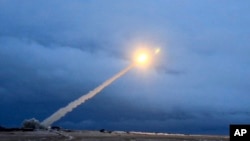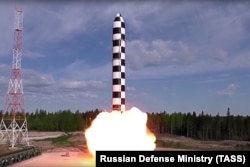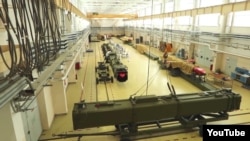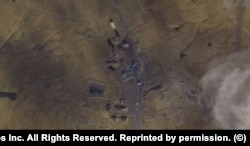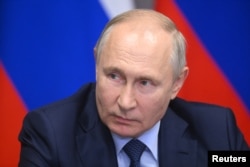On the barren Arctic archipelago of Novaya Zemlya, the surge of activity had been watched closely for months: satellite imagery showing an uptick of construction at one, possibly two, settlements that researchers had identified as sites for a possible test of a nuclear device or a new, trouble-plagued missile called the Burevestnik that is under development.
Late last month, a NOTAM – an official warning to airplane pilots about “hazardous operations” – was issued by Russia for the Barents and Kara seas, east and west of Novaya Zemlya. As many as five U.S. military surveillance planes have been tracked south of the archipelago in recent weeks.
Days later, the head of Russia’s leading nuclear research center called for the Kremlin to resume nuclear tests, including at Novaya Zemlya, a move that would end a 33-year moratorium and deal a big blow to global nonproliferation efforts.
President Vladimir Putin weighed in on October 5: “I am already hearing calls, for example, to start testing nuclear weapons, to return to testing,” he told an audience of Russian and foreign analysts.
“We conducted the final successful test of the Burevestnik nuclear-powered global-range cruise missile,” he also said, adding: “We have actually finished work on the Sarmat, a super-heavy rocket.”
“I’m not ready to say now whether we really need or don’t need to conduct [nuclear] tests,” Putin said, but he signaled Russia would consider withdrawing from a major international treaty that bans all nuclear testing. The 1996 Comprehensive Test Ban Treaty was signed and ratified by Russia, but only signed, and not ratified, by the United States.
“This is a question for the deputies of the State Duma,” he said, referring to the lower chamber of parliament. “In theory, this ratification could be revoked. If we do this, it will be quite enough.”
Nuclear arms treaties, and other major Cold War-era agreements, have been fraying for years now. The United States pulled out of the Intermediate-Range Nuclear Forces Treaty in 2019 after years of accusing Russia of cheating on it. Years before that, Washington withdrew from the Anti-Ballistic Missile Treaty. And the last remaining restraint on Russian and American arsenals, New START, is set to expire in 2026.
As of October 6, there was no independent confirmation of Putin’s statement that Russia had successfully conducted a test of the Burevestnik. Another NOTAM warning off Novaya Zemlya was issued the day after Putin’s remarks. And there is no indication that a test of an actual nuclear device is imminent.
“The overall level of activities appears to support the idea that they are either preparing for testing directly due to a decision by Putin, or are preparing for eventual testing depending on what China and the U.S. do, or as an escalatory measure in the context of Ukraine,” said William Alberque, director of strategy, technology, and arms control at the International Institute for Strategic Studies.
“Testing a nuclear explosive device for the first time since the [Comprehensive Test Ban Treaty] was negotiated would be escalatory and deeply damaging to the nuclear nonproliferation regime,” said Lynn Rusten, a former White House and State Department arms control expert who participated in negotiations on the original New START treaty.
Asked about concerns that Russia was seeking to conduct a nuclear test or a test of the nuclear-powered cruise missile, the U.S. State Department said: “Russia is pursuing novel nuclear weapons that are not currently covered by the New START treaty, such as a nuclear-armed and nuclear-powered ground-launched intercontinental- range cruise missile.
“We are monitoring developments of these systems closely,” a spokesman told RFE/RL on condition of anonymity.
'A Ridiculously Stupid Weapons System'
Arms control experts said a test of either of the two -- the nuclear-powered cruise missile or an actual detonated nuclear device -- would be hugely problematic, though for different reasons.
Dubbed Skyfall by NATO officials, the Burevestnik has been reportedly under development since the early 2010s, according to the Nuclear Threat Initiative, a Washington research organization. However, it was first publicly discussed by Putin during a March 2018 speech in which he bragged about a host of new weapons Russia was developing.
A ground-launched, low-flying, potentially nuclear-tipped cruise missile powered by a nuclear reactor, the Burevestnik would theoretically have a range of up to 23,000 kilometers, meaning it could hit the United States if launched from anywhere inside Russia. The United States experimented with such a weapon in the 1950s and '60s before discarding it as unpractical.
Among the places Russia is known to have tested the Burevestnik is the White Sea, west of the city of Arkhangelsk and the port of Severodvinsk. In August 2019, while officials were trying to raise a Burevestnik missile from the seabed near the town of Nyonoksa, an explosion occurred, spewing radiation over a wide area, including Severodvinsk, and killing at least five Russian nuclear specialists. U.S. officials later concluded that the explosion “was the result of a nuclear reaction that occurred during the recovery of a Russian nuclear-powered cruise missile.”
Researchers at the Middlebury Institute of International Studies in Monterey, California, said Burevestnik testing had resumed in 2021, at a location on Novaya Zemlya called Pankovo, though that was never independently confirmed.
“Burevestnik is just stupid,” Rusten said.
It is “a ridiculously stupid weapons system,” Alberque said.
“Not sure where it sits with the nuclear-powered bomber in the stupid sweepstakes, though,” he added, referring to another weapon Russia has suggested it could build.
Stupid or not, the missile system is not covered by New START. That, plus the fact that its design would make it hard for air-defense systems to detect or intercept, worries U.S. officials.
“We have long said that future arms control agreements must expand to include these types of novel nuclear weapons,” the State Department spokesman said.
'Everything Will Fall Into Place'
Putin’s suggestion that a nuclear test was under consideration was echoed on October 6 by Vyacheslav Volodin, the chairman of the Kremlin-controlled Duma. Volodin pointed to the U.S. unwillingness to ratify the Comprehensive Test Ban Treaty, known as the CTBT, and claimed that Russia, which launched a large-scale invasion of Ukraine in February 2022, is at war with the United States and NATO.
"The situation in the world has changed. Washington and Brussels have unleashed a war against our country. Today's challenges require new solutions,” Volodin said in a post to Telegram. He said lawmakers would “absolutely discuss the question” of withdrawing ratification at their next session.
A test of an actual nuclear device -- even a small-scale detonation of fissile material -- would be more worrisome since it would be the first conducted by Russia since 1990. It would be a definite signal of Moscow’s intention to move to withdraw from the CTBT.
“If there’s a test with a genuine release of energy, we’ll find out about it pretty quickly,” Pavel Podvig, a Geneva-based UN arms control researcher, told RFE/RL. “For example, when North Korea conducted its tests, it was visible almost immediately. And I don’t think anyone will try to hide such experiments.”
It would also undermine the Treaty on the Non-Proliferation of Nuclear Weapons, a Cold War agreement whose signatories include the five major nuclear-armed states -- the United States, China, France, Britain, and Russia, which are also the five permanent members of the UN Security Council.
“Were any of the [five states] to test a nuclear weapon and therefore abandon their parallel unilateral testing moratoria as CTBT signatories, that would be a huge blow to the [nonproliferation] regime and would undoubtedly lead to a cascade of nuke testing by other states,” Rusten said.
On September 28, Mikhail Kovalchuk, who heads the Kurchatov Institute, one of Russia’s leading nuclear research facilities, called for revisiting the country’s deterrence doctrine -- redefining exactly when a nuclear weapon would be used.
He also called for resuming nuclear testing, asserting that the Soviet Union’s 1961 test of the world’s most powerful atomic weapon -- the Tsar Bomba -- spurred the United States to open negotiations with Moscow.
“It’s enough to carry out tests on Novaya Zemlya...at least once,” he was quoted by state news agency RIA Novosti as saying. “And everything will fall into place.”
Arms control researchers have also pointed to the increased pace of construction at known nuclear test sites in China and the United States as cause for concern.
In 2019, under then-President Donald Trump, some U.S. officials reportedly pushed to resume full testing. The official U.S. policy statement on the subject -- the Nuclear Posture Review -- ultimately stated that the United States would not seek to ratify the test-ban treaty, and it would "remain ready to resume nuclear testing if necessary to meet severe technological or geopolitical challenges."
There’s no public indication that Trump’s successor, President Joe Biden, wants to resume full testing. However, the United States is believed to have conducted subcritical tests, in which a detonation does not lead to a fission explosion. Late last month, at a meeting in Vienna, U.S. officials floated a proposal to allow international inspectors to observe U.S. subcritical experiments, a move seen as a possible goodwill gesture.
Resumption of full-blown nuclear testing by either Russia or the United States would likely signal the demise of New START as well, since the treaty cannot be renewed after 2026.
Tensions over Russia’s war against Ukraine have made it impossible for negotiators to hold talks; the two sides have also been unable to agree on letting inspectors into one another’s countries to conduct site visits authorized under the treaty.
In February, Putin announced Russia was suspending compliance with New START.
Dumping Grounds
One alternative explanation for the activity at Novaya Zemlya, in particular at a settlement known as Severny: Russia is looking to ship and store more of the radioactive waste generated from its nuclear-powered ships there.
According to the Barents Observer, the Rosita, a Russian ship specially designed to carry nuclear waste, was spotted moored at Severny.
“The big unanswered question is if what we now are witnessing is a Russia that brings dangerous nuclear waste to Novaya Zemlya for long-term storage in the permafrost,” Frederic Hauge, president of the Norwegian environmental group Bellona, was quoted as saying.




